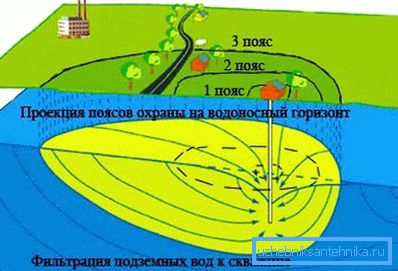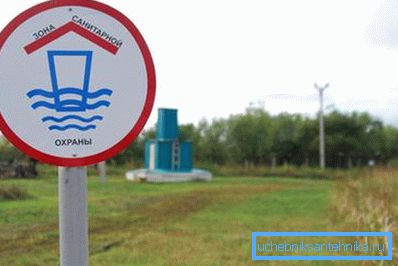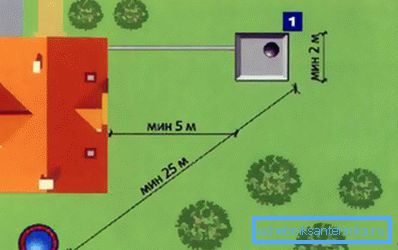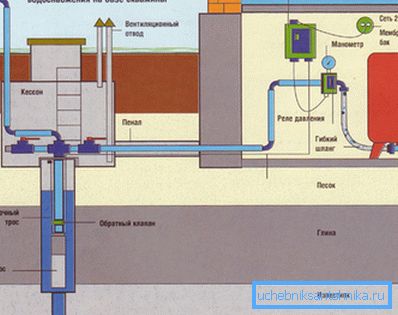Sanitary well zone for a country site
Choosing between a small country house or a modern country house, in any case, you will have to think about the benefits of civilization - about drinking water and electricity. Both that, and another will transform life on the nature into comfort which will not concede to the city.
However, there are some sanitary rules that must be observed when installing a well for water, especially an artesian one, in your area.

According to statistics, the price of land with water and electricity is much more expensive than usual, where there are no such benefits of civilizations. Modern technologies make it possible to turn a lifeless territory into a real oasis.
What you need to know and follow when equipping wells
- The tubular well must necessarily have a cap that rises 80 cm or more above ground level. Its design provides reliable protection of the well from precipitation and dirty water from the soil surface.
- The materials and elements of the well, including the casing, hoses, filter and pump, must comply with sanitary standards approved by the Ministry of Health for drinking water supply systems.
- The tubular well is additionally equipped with a drain pipe, a casing, a bench and a hook for buckets intended for the collection of water.
- Along the perimeter of the well, the site is lined with brick or stone and has a slight inclination in the opposite direction.
Drinking Water Standards
If you were able to drill a well with your own hands or with the help of specialists in accordance with all hydro-technological rules and, observing all sanitary standards, alas, today this does not guarantee a quality drinking water.
After such standards have been established, the chemical industry has stepped far forward, so now even in relatively deep tubular wells traces of phenol, PVC and other substances harmful to health are found in the water.
Tip: at the end of the drilling work, give the water to be tested in the SES to get a conclusion on its suitability for use.
For example, scientists believe that by 2050, the world's population will have a serious problem of lack of clean fresh water. It will not be enough for industrial needs, and for water supply of people.

The analysis as a whole includes:
- organoleptic testing, where taste, color, smell and the presence of suspensions in water are determined;
- identification of the maximum allowable content in the liquid of various elements, including chlorides, heavy metals, sulfates, chemicals of inorganic and organic origin;
- microbiological analysis of water to determine the presence of dangerous microorganisms in it, including E. coli.
Water will be recognized as suitable for cooking only at normal rates in all indicators.
Well maintenance
The presence of a well-equipped drinking well on a country site imposes on the homeowner some responsibilities for its maintenance.
This is not just a wish, but a statutory sanitary instruction that is intended to preserve the purity of this water and prevent microbial or chemical contamination of the drinking source.
- The sanitary zone of the artesian well must be kept clean. Do not wash cars near the source, do not wash clothes, do not wash the dishes, use household chemicals, clean and use modern household chemicals, do not feed or clean cattle nearby.
- Heat the source only with materials that have been approved by the Ministry of Health, for example, it can be hay, shavings, sawdust, any other natural material. At the same time it is not allowed to enter it inside the well. It is forbidden to use synthetic materials - glass wool or foam, and something like that, because if they fall into the well they can pollute the water.
Remember! Freshwater reserves on Earth are small and equal to only 2.5% of all the water on the planet, with a quarter of them located in the depths. If we compare the volume of groundwater and water in rivers, the first indicator will exceed the second by 3000 times.
- Clean, repair and disinfect the well once a year or upon request of the SES. When disinfecting, treat not only the well and water in it, but all the equipment that is used to lift the liquid to the surface.
- When a well has become unsuitable due to chemicals, or water has left it, or pipes or internal cladding have worn out, the water intake structure must be destroyed. Pour the barrel of clay, tamp it down and leave the clay hill in place of the tip up to 300 mm.
- The water supply system from the well to the house must be made of materials permitted by the Ministry of Health, the price of which may differ in a large way from the usual ones. When conducting a qualitative assessment of water, the sample is taken directly from the tap to the dwelling. This makes it possible to establish its safety for the health and plumbing system.
Sanitary areas around the source
Along the perimeter of the underground water intake there should be three zones of sanitary protection of wells, which ensure the sanitary and epidemiological reliability of the source. Their project must be coordinated with the SES authorities.
First belt
The following distances from the artesian well are established for it:
- reliably protected horizons - from 30 m;
- unprotected, insufficiently protected horizons and infiltration water intakes - from 50 m.
The territory is enclosed with a deaf fence, whose height is from 2.5 m. It is not allowed adjoining to it any buildings. For the first security sanitary belt, a guard alarm is provided, but not a dog.

Please note that the zone of sanitary protection of an artesian well is being greened, lit and planned in such a way as to ensure unobstructed drainage of surface water beyond its perimeter. Therefore, rain and melt water should not stagnate for a long time in this belt.
Tip: when settling in a given security zone of a toilet or other structures, they should have a drainage system outside the sanitary protection zone.
In addition, within the limits of the first sanitary security belt for artesian wells it is prohibited:
- conduct any type of construction, except for reconstruction works or to increase the main water supply structures;
- to build ancillary buildings that are not directly related to water treatment. They must be placed outside the first sanitary zone;
- to build residential and public buildings for people, even if they are working on the water supply;
- lay pipelines for various purposes, except for pipelines that serve waterworks;
- release sewage into surface sources, bathe, arrange grazing and watering livestock, do laundry, engage in fishing, apply fertilizers and toxic chemicals to plants.

The second belt of sanitary protection of the well
On its territory is prohibited:
- build livestock farms located closer than 300 m from the borders of the first sanitary zone;
- arrange grazing of cattle and its camps, if they are closer than 100 m from the line of the second belt.
It must be remembered that any construction within the second sanitary zone is necessarily coordinated with SES. In order for the well to be operated normally, its wellhead is placed in a recessed chamber (caisson), providing the necessary waterproofing.
Tip: do not allow the release of groundwater and their accumulation at the bottom of the caisson.
It is also prohibited in the second sanitary security zone of the surface water intake:
- to pollute the territory with garbage, sewage, waste, manure, etc .;
- arrange warehouses for fuels and lubricants, mineral fertilizers and toxic chemicals, sludge storages, storage tanks and other objects that are capable of polluting water sources with chemicals;
- place cemeteries, cattle cemetery, landfill fields, filtration fields, fields for agricultural irrigation, manure storage, silage trenches, livestock and poultry farms and other facilities that can cause microbial contamination of drinking water wells;
- apply fertilizers and pesticides.

Third Belt Sanitary Security Belt
It is needed to protect an underground water well from chemical contamination. Its boundaries are determined based on the rate of migration of chemical harmful substances. In this case, the estimated term of its operation will be from 25 years.
There are some restrictions on the use of the third belt section of the sanitary security zone. For example, you cannot build or install here any objects that can chemically pollute a territory.
Including they include:
- sludge collectors;
- warehouses of fuels and lubricants, toxic chemicals and mineral fertilizers.
When calculating the sizes of the second and third zones of sanitary protection of a well, a certain period of time is taken as the basis for which chemical or bacterial contamination approaches the water intake.
Tip: when placing the boundaries of the belts, it is necessary to ensure maximum protection of the water source from any contamination.
Memo for owners of country houses and country houses
Today, suburban development is experiencing a boom, but the land is sorely lacking. Therefore, it happens that the wells are drilled just 10–20 meters apart.
In this case, it is not possible to ensure full compliance with sanitary and security regulations. And it is clear why, the area of your suburban area is significantly smaller than the required security zone of the drinking water well, and you only have to guess how your neighbors treat them.

In this case, you should understand that the wells drilled to the first aquifer level cannot guarantee the purity of the water being raised to the surface. This is due to the fact that an active pollutant will be detected within a radius of 50 m. It can be a toilet with a cesspool, a crib for animals, a place for washing vehicles, and also drainage wells for draining plots.
They are also drilled to the first water horizon, which is used by summer residents, who do not have the means to build artesian tube wells. So not only the second, but also the full-fledged first layer of the sanitary security zone in its suburban area is very, very difficult to achieve, and in most cases it is simply impossible.
Conclusion
Mandatory protection zone around the sand and artesian wells makes it possible to maintain the quality of drinking water and protect the source from possible chemical, bacterial and other contaminants. It is not always possible to create such a sanitary belt around the perimeter of tubular wells made on a country site. In the presented video in this article you will find additional information on this topic.